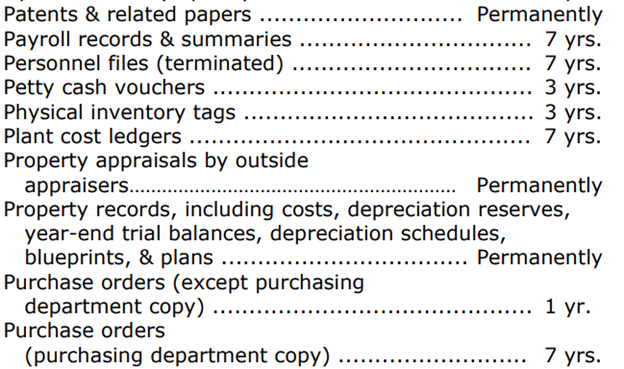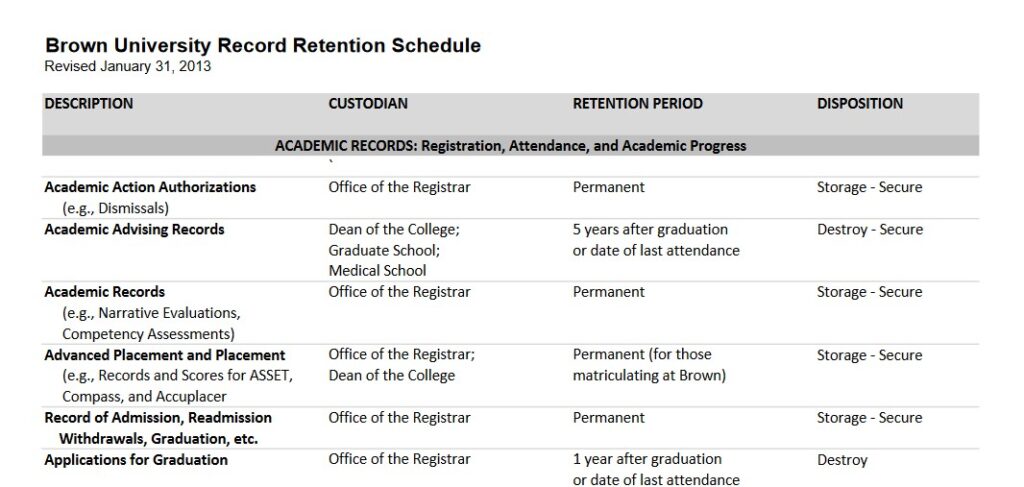A Retention Schedule is the most important document in Records Management. It contains a list of every kind of record a company has, and how long they need to keep it. Records Managers use the retention schedule as the primary planning document to control their records management program.
More advanced retention schedules will also include instructions to figure out what type of record a document is based on how it’s used. Some may keep track of what department is responsible for each type of record, and other retention schedules may control what should be done with the record when it’s no longer being used.
From time to time, the rules about a document may change, or new types of documents may be created, and the list will have to be updated to include that new information. By making those changes in one place, the retention schedule provides an easy way for an entire company with many employees to standardize their rules about how long to keep records. The Retention Schedule is created and managed by the Records Manager.

In its simplest form, a Retention Schedule is a list of types of records and how long to keep them.
How do you determine how long each record is kept?
All records/non-records have a length of time they are to be kept. This is called a “retention life”. The retention life is included in the retention schedule.
What determines the length of time records are to be kept? Laws. Laws can be local, state, national, Federal, or International. It depends where your organization is located and operates. Some companies are only in one state which makes these rules simpler. Another company may operate across the East Coast of the US, from Maine to Florida. In this case, they will need to know the laws in every state they do business. They will also need to understand any federal laws that apply to their records and decide how long each should be kept. What determines how long a non-record is kept? That is usually determined by the owner of the non-record. The owner of the non-record is the business unit that creates and uses it. With no law guiding its disposition, a non-record may be kept as long as you want.
What is a Record Category?
A Records Category are those records that are related to a particular function in an organization or related to a particular business unit. A functional example would be “vital records”. Vital records are those records that are fundamental and necessary for continued operations of an organization. An example of a records category for a business unit would be records from an Accounting Department.
What is a Record Series?
A Records Series are similar records under a Records Category. We’ve identified above that Accounting records can be a Records Category. There could be records created by them for Accounts Payable, Budgeting, or Payroll. Each of them would be a series under the category of accounting.

What are the parts of a Retention Schedule?
The columns of a retention schedule tell you everything you need to know about each record.
1. Record Series ID
The Record Series ID is the “code name” for each type of record. Records Manager will create Record IDs for each record. Record IDs for departments may start with a similar set of letters. Some codes you can figure out who the records belong to by those letters. For example, a code that starts with “AC” may be a record from the Accounting Department. If it starts with “HR” it may belong to the Human Resources Department. The ID provides a convenient way to show that records are all the same type.
2. Record Series Name
The Record Series Name is a title for each type of record. It’s a short in length. Just enough to let you know what the records is. For example, in the Human Resources Department they will have a record series called “Job Applications” and a record series called “Job Descriptions”.
3. Record Series Description
The Record Series Description is a detailed explanation about each type of record. Some descriptions can be a few words. Other kinds of records may require a longer and more complex description.
4. Retention Life for Records & Non-Records
As noted in the beginning of this article, records are part of the Retention Schedule. The Retention Life is how long we must keep each type.
- Retention Life for Records
The laws for how long we keep records come from multiple areas. The laws could be local, state, federal or even international. If your company is one state, that reduces the laws you must research. If you have locations on the East Coast, that increases your research. If your company is International, then your Records Managers will have a lot of research to do!
- Retention Life for Non-Records
Non-records are defined as those records that have no legal reason to keep. They are used in our daily operations. But there is no law saying when we must dispose of them. Non-Records MUST be managed too. You should retain non-records if they are needed. Then they should be disposed of. Retention for non-records can be determined by the records owner.
5. Legal Citation
A legal citation in records management is a reference back to a document or source that supports the life a record should be kept. Sources for legal citations could be court decisions, statues, regulations, or government rulings.
6. Record Owner
Every record has an owner. An owner is the business unit that creates it and uses it. Records managers will work with the owner to make sure they have all the details of the record which will be used in the retention schedule.
7. Retention Schedule Review Update
Creating your retention schedule is a great start. But it doesn’t end there. New records can be added when they’re created. Existing records and their retention lives should be reviewed to make sure they’re still accurate at an agreed upon point in the future. The Records Manager will decide when that should happen. An update could be scheduled every two or three years. Another way to perform the update is to take a part of your retention schedule each year and update it. Updating your retention schedule in parts, gives you multiple smaller projects spread out over time which may be easier than one BIG project all at the same time.
8. Disposition Action
Creating your retention schedule is a great start. But it doesn’t end there. New records can be added when they’re created. Existing records and their retention lives should be reviewed to make sure they’re still accurate at an agreed upon point in the future. The Records Manager will decide when that should happen. An update could be scheduled every two or three years. Another way to perform the update is to take a part of your retention schedule each year and update it. Updating your retention schedule in parts, gives you multiple smaller projects spread out over time which may be easier than one BIG project all at the same time.
At the end of their retention life, Records/non-records will be disposed of. This is called disposition. Disposition may be the destruction of the record, keeping it permanently if that’s the law, or transferring it to another entity, such as NARA (National Archives and Records Administration).
Not all retention schedules contain all of the parts as listed above.
Some are very basic: https://www.bbb.org
Some are more detailed: https://policy.brown.edu
What is a File Plan?
A file plan is a list of documents to be retained in a specific file. The records are indexed into that file when they are ingested into the system. Let’s use your employee file as an example. On date of hire all your personal information is entered into a record that goes into that file. As you continue working for that company you may have an annual performance evaluation, a job promotion form, or perhaps you changed positions within the company. That form will be included too.
Taxonomy
A taxonomy is an approved list of words that we use to describe records. You want to make sure that everyone is using the same words to describe the same thing. If different words are used to describe, it can get confusing. For example, let’s say we apply for a credit card. Because it’s a new account, the Records Manager identifies that record as a “new account form”. But the employee issuing the credit card identifies it as “onboarding data” because that’s what the software company called the form. They’re talking about the same thing, but not using the same words to describe it. Using taxonomy in your retention schedule, ensures you use the same terminology.
How do you create a Retention Schedule?
Step One: Record Survey
A Records Survey is a list of questions that are sent out to each business unit. The questions ask them to identify all the records that they create and use. This is done in advance of the Records Inventory which is done in-person with each business unit.
Step Two: Records Inventory
Records are created all throughout an organization. A Records Manager must know all these records. The starting point of a retention schedule is to create a list of those records. That list is called a Records Inventory. A Records Manager or one of their staff will meet with each department in their organization. They will discuss all the records that department creates or uses. From that discussion, a detailed list of each record will be created.
Whenever possible, get a sample of the record as a reference. It is important to know what information the record contains. There may be PII (Personally Identifiable Information) in the record. PII needs to be protected so access is only granted to those people that should have it. It is also important to know where the path each record travels in an organization. Does the record stay within that department? Does that department forward the record to another department? All this information will be listed in the Records Inventory.
When all the records have been identified, they are ready to move on to creating the retention schedule.
Step Three: Creating the Schedule
Once the records inventory is complete, you will create a document to list all the records you discovered with all of their information. The easiest format to create this list is in a spreadsheet. It allows you to list things in columns and rows. You will create column headings for each of the things we discussed in “What are the parts of a Retention Schedule”. You will not have all the information about each record yet. There is research to do to find out how long each record should be kept. Some columns will be blank.
Researching the Retention Life for each record – This is a very important part of the process as you must keep your records as long as the law says. This research can be completed in different ways:
- You perform the research yourself – If you are only located in one state it will be easier and less time than if you were in multiple states. Performing the research by yourself means that you would visit each local, state, and federal web site to search each record and what they list as the time they should legally be kept.
- Use record retention schedule software – There are several companies that allow you to use their software to search for the retention of each record in your retention schedule. You will need to know that their software has the retention for the states you’re in. There will also be a cost to use their software.
- Use a consultant to do the research for you – If you do not have the staff or the time to do it yourself, consider using a consultant. Yes, there will be a cost for them to do this. It will be more expensive than using software on your own. You are paying for their knowledge and their time to do the research.
Select how long you’re going to retain each record and add it to the Retention Schedule – If you are only in one state, then the decision is easier. First, compare the State Law against the Federal law. There may not be a Federal Law for each record, only a state law. If you have both a State and a Federal law governing a record, you need to check to see if one of those laws picked as the one to follow. At times the Federal law overrides the State law, but not always. If you are in multiple states, you will need to compare all the State laws to the Federal law if there is one, and then make your decision. For example, when an employee leaves an organization, retention will begin as a terminated employee. Each state may have a different time you need to keep that information.
Step Four: Approving the Retention Schedule
When you finish adding the information you need to the retention schedule, it should be approved before sending it out to all the departments in your organization. You do want to start the approval process by sending the retention schedule to the people in the departments you did the records inventory with. They will review the area of the retention schedule for their area only. Depending on the size of your organization, you may have a legal department. They would give the approval for the use of the retention schedule. For smaller organizations that may not have a legal department, find out who the authorized department is.
Success! Once the retention schedule is approved, it can be distributed to the business units in your organization who will use it.




